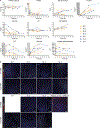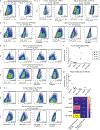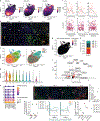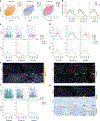AAV capsid prioritization in normal and steatotic human livers maintained by machine perfusion
- PMID: 39881029
- PMCID: PMC12304247
- DOI: 10.1038/s41587-024-02523-6
AAV capsid prioritization in normal and steatotic human livers maintained by machine perfusion
Abstract
Therapeutic efficacy and safety of adeno-associated virus (AAV) liver gene therapy depend on capsid choice. To predict AAV capsid performance under near-clinical conditions, we established side-by-side comparison at single-cell resolution in human livers maintained by normothermic machine perfusion. AAV-LK03 transduced hepatocytes much more efficiently and specifically than AAV5, AAV8 and AAV6, which are most commonly used clinically, and AAV-NP59, which is better at transducing human hepatocytes engrafted in immune-deficient mice. AAV-LK03 preferentially transduced periportal hepatocytes in normal liver, whereas AAV5 targeted pericentral hepatocytes in steatotic liver. AAV5 and AAV8 transduced liver sinusoidal endothelial cells as efficiently as hepatocytes. AAV capsid and steatosis influenced vector episome formation, which determines gene therapy durability, with AAV5 delaying concatemerization. Our findings inform capsid choice in clinical AAV liver gene therapy, including consideration of disease-relevant hepatocyte zonation and effects of steatosis, and facilitate the development of AAV capsids that transduce hepatocytes or other therapeutically relevant cell types in the human liver with maximum efficiency and specificity.
© 2025. The Author(s).
Conflict of interest statement
Competing interests: The authors declare no competing interests.
Figures














References
-
- Zabaleta N, Unzu C, Weber ND & Gonzalez-Aseguinolaza G Gene therapy for liver diseases—progress and challenges. Nat. Rev. Gastroenterol. Hepatol. 20, 288–305 (2023). - PubMed
-
- De Wolf D, Singh K, Chuah MK & VandenDriessche T Hemophilia gene therapy: the end of the beginning? Hum. Gene Ther. 34, 782–792 (2023). - PubMed
-
- Gramignoli R, Vosough M, Kannisto K, Srinivasan RC & Strom SC Clinical hepatocyte transplantation: practical limits and possible solutions. Eur. Surg. Res. 54, 162–177 (2015). - PubMed
-
- Piccolo P, Rossi A & Brunetti-Pierri N Liver-directed gene-based therapies for inborn errors of metabolism. Expert Opin. Biol. Ther. 21, 229–240 (2021). - PubMed
Grants and funding
- DP1 DK130689/DK/NIDDK NIH HHS/United States
- P30 DK026743/DK/NIDDK NIH HHS/United States
- EDUC4-12812/California Institute for Regenerative Medicine (CIRM)
- RAP Team Science Grant/UC | University of California, San Francisco (UC San Francisco)
- DP1DK130689/U.S. Department of Health & Human Services | NIH | National Institute of Diabetes and Digestive and Kidney Diseases (National Institute of Diabetes & Digestive & Kidney Diseases)
LinkOut - more resources
Full Text Sources

